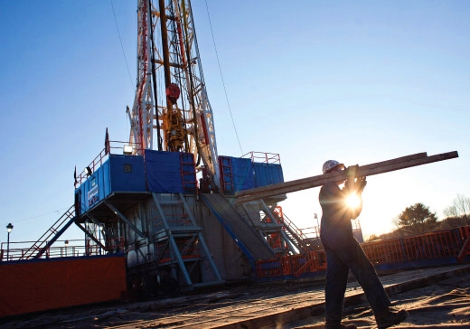Get Fracking!

By Mary Lord
What’s relatively clean-burning, abundant, and possibly the next big thing in reducing America’s carbon footprint? Would you believe… natural gas?
Vast reserves – about 827 trillion cubic feet, more than double the 2010 estimate – lie locked in the porous shale fields deep below the Earth’s crust. That makes them hard to tap.
Engineers have developed a horizontal drilling technique known as hydraulic fracturing, or “fracking,” that frees the trapped gas much like blowing bubbles through a bent soda straw. In fracking, however, a high-pressure mix of water, sand, and chemicals – some toxic – is pumped into underground fissures in the rock, creating new channels and releasing the gas for recovery.
Though the method was invented in 1947, it took 50 years before advances made extraction economical. In 2000, just 1 percent of America’s natural gas supply came from shale beds, mostly in Texas. Today, that figure has reached nearly 25 percent, with fracking operations stretching from Pennsylvania to California. The vast shale reserves in four states – Pennsylvania, New York, West Virginia, and Texas – could power the country for 110 years.
As fracking has spread, so have concerns about its potential health and environmental impacts, including ground water contamination and air pollution. A series of articles by the public-interest journalism group ProPublica lays out what’s known so far.
Engineers are deeply involved not only in extracting and transporting the natural gas, but in investigating the impact of fracturing on the environment.
Despite the risks, energy experts predict a “golden era” for natural gas. One MIT study, for example, estimated that replacing U.S. coal-fired electric plants with cleaner-burning gas and conserving energy could cut carbon dioxide emissions by up to 50 percent by 2050. If more cars and buses ran on natural gas, it also could help reduce America’s dependence on imported oil.
One thing’s for sure: The natural gas boom has boosted demand for petroleum engineers. They already out-earn any other engineering degree, with starting salaries of around $100,000 a year. Now, schools like the University of Houston, which is expanding its petroleum engineering program, report stiffer admissions competition and great job prospects. According to Fortune magazine, nearly all the petroleum engineering grads from schools like Texas A&M and the Colorado School of Mines last year found employment.
Kelvin Gregory, a civil and environmental engineer at Carnegie Mellon University who is leading a three-year study on ways to improve the recycling of fracking fluids, jokes that one of his recent graduates went to work for a leading petroleum-industry company – and now earns twice his professor’s salary.
This post was condensed from a September, 2011, feature in Prism magazine by Thomas K. Grose. Read the full article HERE.
Filed under: e-News, Explore Engineering, Mining
Tags: carbon footprint, Energy, fracking, hydraulic fracturing, natural gas, petroleum engineering, shale









